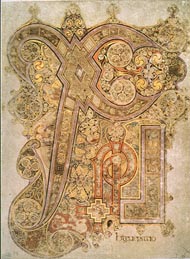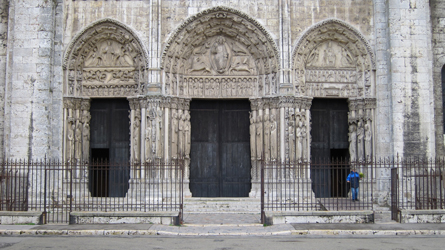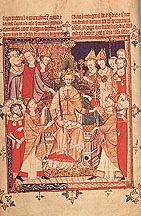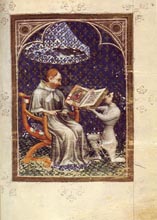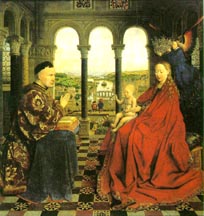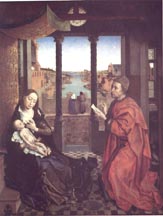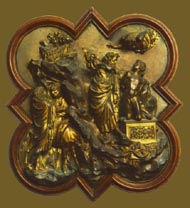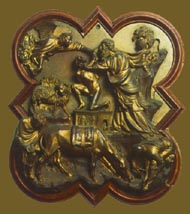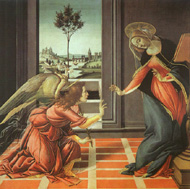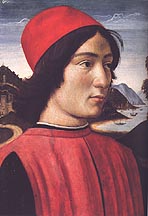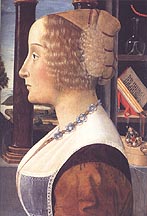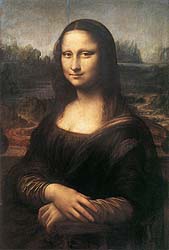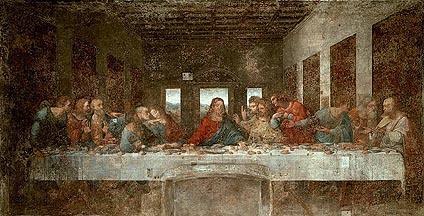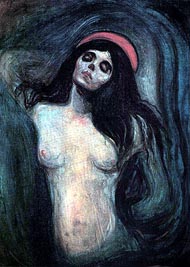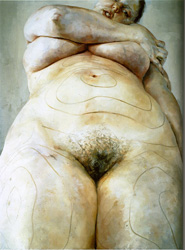Art Home | ARTH Courses | Syllabus
ARTH 110: Survey of the Visual Arts II:
Renaissance to Modern
College Scholars
Assignments
Tuesday, September 2: Medieval Background: In order to gain a perspective for the development of the idea of the artist in the Late Medieval and Early Renaissance, I think it is important to consider the different roles of the artist in the Middle Ages. I want to consider the artist as monk. Here I want to consider the creation of one of the major monuments of the Early Middle Ages: the Chi-Rho page from the Book of Kells
As an introduction to this work review the web-page dedicated to the Chi-Rho page I have prepared for my Medieval Art class. In considering this page you might want to think about the attitudes of the monk in making this page. How did he look upon his work? What were his priorities?
Another major context of Medieval Art I would like to consider are the so-called Royal Portals of Chartres Cathedral:
These doors mark the primary entrance to this major Gothic Cathedral. Review the web-page I have developed for the Royal Portals again for my Medieval Art class. The name for these portals is derived from the series of Kings and Queens that decorate the jambs or sides of the doorways. Look at the images of these figures included in the web-page. What do you make about the approach to individuality the artists took in creating these figures? We know that a major project like this doorway entailed the activity of a team of sculptors. What do you understand were the priorities of the artists making these figures?
Thursday, September 4: Read page entitled Medieval Guilds and Craft Production. Although the majority of the page is dedicated to workshop production in northern Europe, especially the book industry in Paris, I have included on this page excerpts from Cennino Cennini's Craftsman's Handbook. Cennini, an Italian painter from the end of the fourteenth and the beginning of the fifteenth century, presents in this text attitudes about the nature of the artistic practice that echo what we find in northern Europe. Read this excerpt carefully, and comment in your journal what strikes you about the nature of the conception of the artist expressed in this text. A complete English translation of Cennini's text is available on the web. I don't expect you to read the complete text, but I would like you to at least consider the Contents to get a sense of the direction of the text.
Tuesday, September 9: the fourteenth and fifteenth century witnessed the emergence of a different social role for the artist. Artist could gain high social status by becoming members of aristocratic households and filling the role of Court Artist. Read the page entitled the Court Artist. As part of our discussion I want to examine an important shift in conception of portraiture as exemplified by the following comparison:
For a more detailed discussion of this read the page entitled Court Culture: Representations of Intimacy. What do you see as the major differences between these two images? How would you explain the reasons for the differences? Certainly there are major stylistic differences in the conception of space and the treatment of the figures, but do these differences explain the reasons for the shift in conception?
If we have the time on Tuesday's class I would like to begin a discussion of the comparisons of the work of Jan Van Eyck in particular his Rolin Madonna to the work of Robert Campin/Master of Flémalle, especially the Madonna of the Firescreen. These comparisons are introduced at the end of the page dedicated to the Court Artist.
For a general art historical discussion of the art of this period read Chapter 20 in Gardner, pp.558-587 (especially pp. 560-578).
Thursday, September 11: I want to devote today's class to the art of Jan Van Eyck. In preparation for this I would like you to review the webpages I have constructed for my Northern Renaissance art class examining the art of Van Eyck: Jan Van Eyck as a Court Artist, The Work of Jan Van Eyck and Religious Vision, and the Arnolfini Wedding Portrait.
Tuesday, September 23: we will be continuing our discussion of Jan Van Eyck, but I would also like to throw in the mix the work of his slightly younger contemporary Rogier van der Weyden. A good comparison can be made between Jan's Rolin Madonna (left) and Rogier's painting of St. Luke Drawing the Virgin (right):
Scholars frequently argue that Rogier's painting was intended as his "masterpiece" for entrance into the Painter's Guild of Brussels. St. Luke, who was believed to have drawn the Virgin, was the patron Saint of painter's guilds. In your journal, consider the question of originality raised by this comparison. Do you consider Rogier's painting to be a "masterpiece"? What is your conception of a "masterpiece"? Consider the excerpt from Walter Cahn's book: Masterpieces: Chapters on the History of an Idea. In considering this, you might reconsider the material presented in the Medieval Guilds and Craft Production page, especially the Cennini excerpts.
Thursday, September 25: we will shift our discussion from northern art to the art of Renaissance Italy of the early fifteenth century. As an introduction read Chapter 21 of Gardner. Focus in particular on pp. 588-605.
A critical moment in early Renaissance art was the competition in 1401 for the commission to make the east doors of the Baptistry of Florence. I have prepared for my Italian Renaissance Art course a page dedicated to the Baptistry Door Competition. We still have two of the panels that were made for this competition: one by the apparent winner of the competition Lorenzo Ghiberti (left) and the other by Filippo Brunelleschi:
As I ask you in the webpage dedicated to this competition, I would like you to take on the role of judge and select which work you consider to be the "winner." What is important is not getting the right answer, but is supporting your verdict with a justification. Base your judgement on not just the visual evidence of the panels but also on what you know about the two artists as suggested by the texts included in the webpage (Ghiberti's Commentarii and Antonio Manetti's The Life of Filippo di Ser Brunellesco). Introductory Material for ARTH 213.
Tuesday, September 30: "Competing Identities": Variety in Early Fifteenth Century Florentine Painting. We will be focusing principally on the art of Masaccio and Gentile da Fabriano. In preparation for this look at the webpage entitled Masaccio and Gentile da Fabriano: Competing Modes. A major monument we will be considering will be Masaccio's paintings in the Brancacci Chapel. The Christus Rex website has an excellent series of illustrations from the Brancacci Chapel. You can also look at the Web Gallery of Art page dedicated to the Chapel. Read Gardner, pp. 600-605. Consider also Slide List 4 from the ARTH 110 class.
Thursday, October 2: we will focus on a comparison of two major fifteenth century Italian painters: Piero della Francesca and Sandro Botticelli. These two artists have been selected since they represent the divergent interests of the period. As a way of giving a focus to our discussion consider the comparison below of images of the Annunciation by these two artists:
We will be considering other examples of the work of these artists. Consult the Slide List dedicated to their work that is included in my regular ARTH 110 class. In our discussion we will pay special attention to Botticelli's Birth of Venus and his other "mythologies." Read Gardner, p. 615 and 630-632.
Thursday, October 9: No Art History survey course dealing with Renaissance to Modern Art can avoid a discussion of Leonardo da Vinci's Mona Lisa. This class is no exception. With our theme of the nature of the artist this painting is particularly relevant. I want to explore the painting in relationship to Leonardo's attitudes about the relationship between art and science. We will consider excerpts from Leonardo's Notebooks that are relevant for considering the painting. These are included on my Slide List dedicated to Leonardo. You should also read Gardner, 634-642.
This painting can also be seen to have a privileged position in feminist discussions. This is brought out by a comparison between Leonardo's painting and the convention of the female portrait in fifteenth century art as exemplified by the following comparison:
|
Domenico
Ghirlandaio, Portrait of a Husband and Wife, c. 1490
|
|
For a discussion of the Ghirlandaio painting in the context of the convention of the profile portrait see the excerpts from Patricia Simons, "Women in Frames: The Gaze, the Eye, the Profile in Renaissance Portraiture". For a general discussion of the position of women in fifteenth century Florence see the excerpts from Dale Kent, "Women in Renaissance Florence." For a recent feminist discussion of Leonardo's painting see the excerpts from Mary D. Garrard, "Leonardo da Vinci: Female Portraits, Female Nature."
Thursday, October 16: like the Mona Lisa, Leonardo's Last Supper is a work that needs to be examined in any survey of Western Art since the Renaissance. As a way of giving focus to our discussion consider the painting in relationship to the following quotation from Leonardo's Notebooks:
| The painter in his harmonious proportions makes the component parts react simultaneously so that they can be seen at one and the same time both together and separately; together, by viewing the design of the composition as a whole; and separately by viewing the design of its component parts. |
Here Leonardo is expressing his approach to compositional unity, but again we must be aware of the relationship of his art to his view of the world. We see expressed here an idea that can be traced back to Greek philosophy that the world should be seen as a harmony of the parts. In exploring the world the scientist and artist bring out the fundamental unities of the interdependent parts.
Compare closely Leonardo's composition in the Last Supper to that found in the work of the same subject matter by the Florentine artist Andrea Castagno painted about 1450:
|
Leonardo da Vinci, Last Supper, c. 1495-98, Refectory of Santa Maria delle Grazie, Milan. |
As a way of giving focus to your consideration of this comparison identify the figure of Christ in the two works, and define the different ways you know which figure is Christ.
Tuesday, October 21: in our discussion of the Last Supper by Leonardo da Vinci we considered the idea of "the harmony of the parts." As we noted this is an idea that can be traced back to Greek thought. It was a powerful idea in Renaissance culture. As another clear demonstration of the importance of this idea, I want to consider a major fresco cycle by Leonardo's younger contemporary Raphael. In painting cycle in the Stanza della Segnatura that is part of the Papal apartments in the Vatican, Raphael laid out the cycle to emphasize his belief in the fundamental unity of all knowledge. Consider the images found on the page I have constructed illustrating the Stanza della Segnatura. Pay special attention to the painting traditionally entitled The School of Athens. Compare the organization of this work to Leonardo's Last Supper. Read Gardner, pp. 653-657.
Thursday, October 23: we will consider the art of Michelangelo. Our discussion will focus primarily on the major images of his David (1501-04) and his Creation of Adam (1508-12). Consult my webpage dedicated to Michelangelo for these images. You should also read Gardner, pp. 645-651.
At the beginning of the class, we will workshop drafts of your papers. Each student will have at least two other students read and comment on their papers. Make sure that you bring your draft to class.
Tuesday, October 28: we will be continuing our discussion of Michelangelo.
First Paper Assignment: due Tuesday, October 28.
Tuesday, November 4: Titian's Venus of Urbino was not the first female nude in Renaissance art, but it is a work that has assumed a central position in narratives of Western art as the great example of the nude. Review the webpage composed of recent critical responses to the Venus of Urbino in preparation for Tuesday's class.
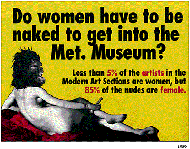
Thursday, November 6: The Art of Albrecht Dürer and the Changing Conception of the Artist. Review web-page entitled Albrecht Dürer: the Human Figure and The Self Portraits of Albrecht Dürer. We will be examining in particular Albrecht Dürer's self-portraits. We will examine how Dürer "fashions" different identities for himself out of the different types offered by his culture. In preparing for this class pay special attention to the excerpts from primary documents concerning Dürer. Note the different attitudes about the nature of the artist represented in the excerpts pertaining to Dürer's father and Dürer himself.
Tuesday, November 11: we will continue our discussion of Albrecht Dürer with looking at his images of Melencholia I and the Artist Drawing the Nude. Both are included on the webpage dedicated to the Self-Portraits of Albrecht Dürer. Consider these as different conceptions of the artist and as different ways to "know" the world. This will lead to a discussion of Hans Holbein's Ambassadors. Begin to explore the website I have dedicated to this painting.
Tuesday, November 19: We will turn to an examination of nineteenth century art. I have prepared a gallery of examples of Nineteenth-Century Images of Women. Review these images. Select three of these, a outline your gender reading of these images in your journal. If you are interested in the theme of Orientalism you can consult the webpage that I have begun to construct dedicated to this topic. The page includes some excerpts from Edward Said's influential book entitled Orientalism. Pay attention to the eerie echoes of our current foreign policy debates.
Thursday, November 20:we will be focusing on the construction of gender in Impressionist art. Consider the images of Manet included on the page dedicated to Nineteenth-Century Images of Women. We will focus particularly on Manet's Olympia. On the webpage I have dedicated to this painting, I have included some excerpts of the contemporary critical responses to the painting. Why would would this image seem scandalous when paintings like Titian's Venus of Urbino, which is a direct source for the Manet painting, were treated as revered masterpieces. At the same time a painting like Alexander Cabanel's Birth of Venus was an award winner at the Salon. I would also like you to read the excerpts from Griselda Pollock's "Modernity and the Spaces of Femininity." This is a challenging article, but if you put the time into it, you will find it opens up interesting critical perspectives. There are some excellent comparisons between male and female artists' visions of gender included in the article.
Tuesday, December 2: we will be focusing on the art of Post-Impressionism, more specifically that of Paul Gauguin. Where the Impressionists have been called the "painters of the modern world", Gauguin withdrew from the modern world in search of something he deemed more authentic and essential. After a stay in the province of Brittanny, Gauguin left Europe for the south Pacific. Central to an understanding of Gauguin's art is coming to an understanding of the concept of the "primitive" as it developed in European culture at the end of the nineteenth century. The fascination with the "primitive" would be an important current in the development of Modern Art. Review the page I have constructed giving recent critical evaluations of the idea of the "primitive." Consider Gauguin's paintings included on the web-page dedicated to Nineteenth-Century Images of Women. Note the central role gender and more specifically the female body play in his art.
If we have the time, I would like to also consider the art of Edvard Munch. Here I would like to consider his work entitled Madonna.
Thursday, December 4: I want to consider one of the major artistic statements of Modern Art, Pablo Picasso's Les Demoiselles d'Avignon. I want to examine it in the context it plays in the narratives of the development of Modern Art. This narrative is made manifest not just in the art historical discussions, but in the lay-out of museums. Read the excerpts from Carol Duncan's essay entitled "The MoMA's Hot Mamas." This essay makes explicit the central role the female body has played in the development of Modern Art. See the connections between the art of Picasso and de Kooning discussed in Duncan's essay and the art of Gauguin and Munch we discussed on Tuesday.
Tuesday, December 9: as I promised earlier in the semester, I would like to dedicate our final meeting next week (Tuesday, December 16, 2:00) to watching the movie Frida. In preparation for this I want consider her work. Review the webpage I have dedicated to the Art of Frida Kahlo. As you review the gallery of her work, consider her identity in relationship to contemporary discussions of Identity and Difference. Identify the different cultural, social, and artistic traditions that you can detect in her work.
Thursday, December 11: We will consider the work of Cindy Sherman and Jenny Saville. Consider these two artists' self-representations. As part of your consideration of the Saville painting entitled The Plan compare it to the image of Albrecht Dürer of the artist drawing the nude.
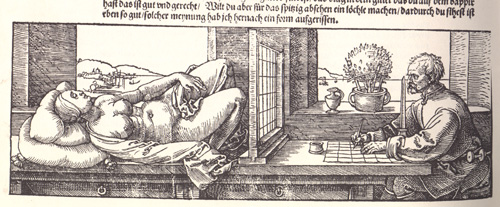
Second Paper Assignment: Due Tuesday, December 16: I want to give you an open-ended assignment of picking a work of art or a comparison of works and write a three to five page paper discussing the art historical significance of the work or comparison. E-mail me your ideas for the paper. You need my approval in order to make sure that the topical is manageable and so that I can give you some suggestions for the direction and focus of your paper.
Last Meeting: Tuesday, December 16, 2:00 PM: we will watch Frida. Papers and journals are due.
